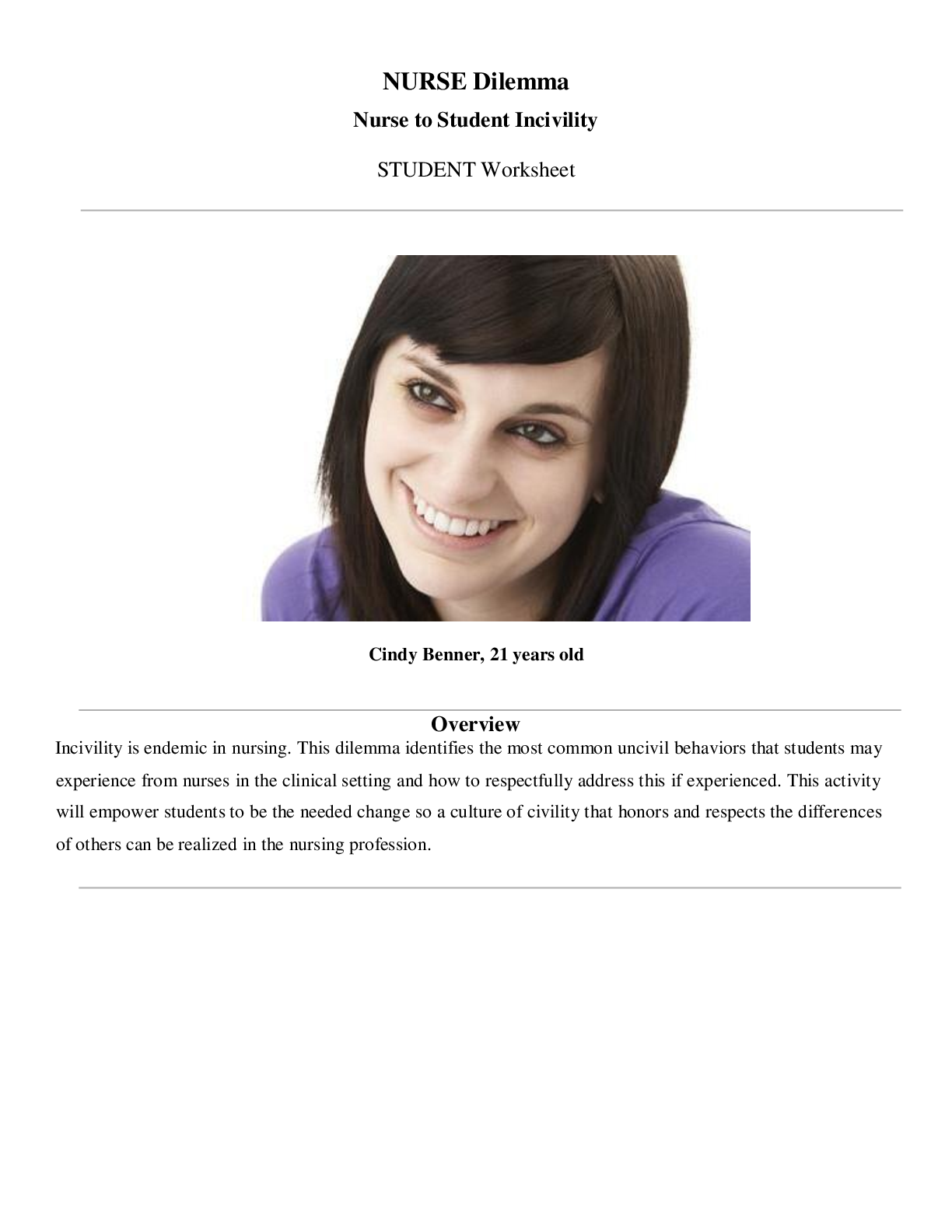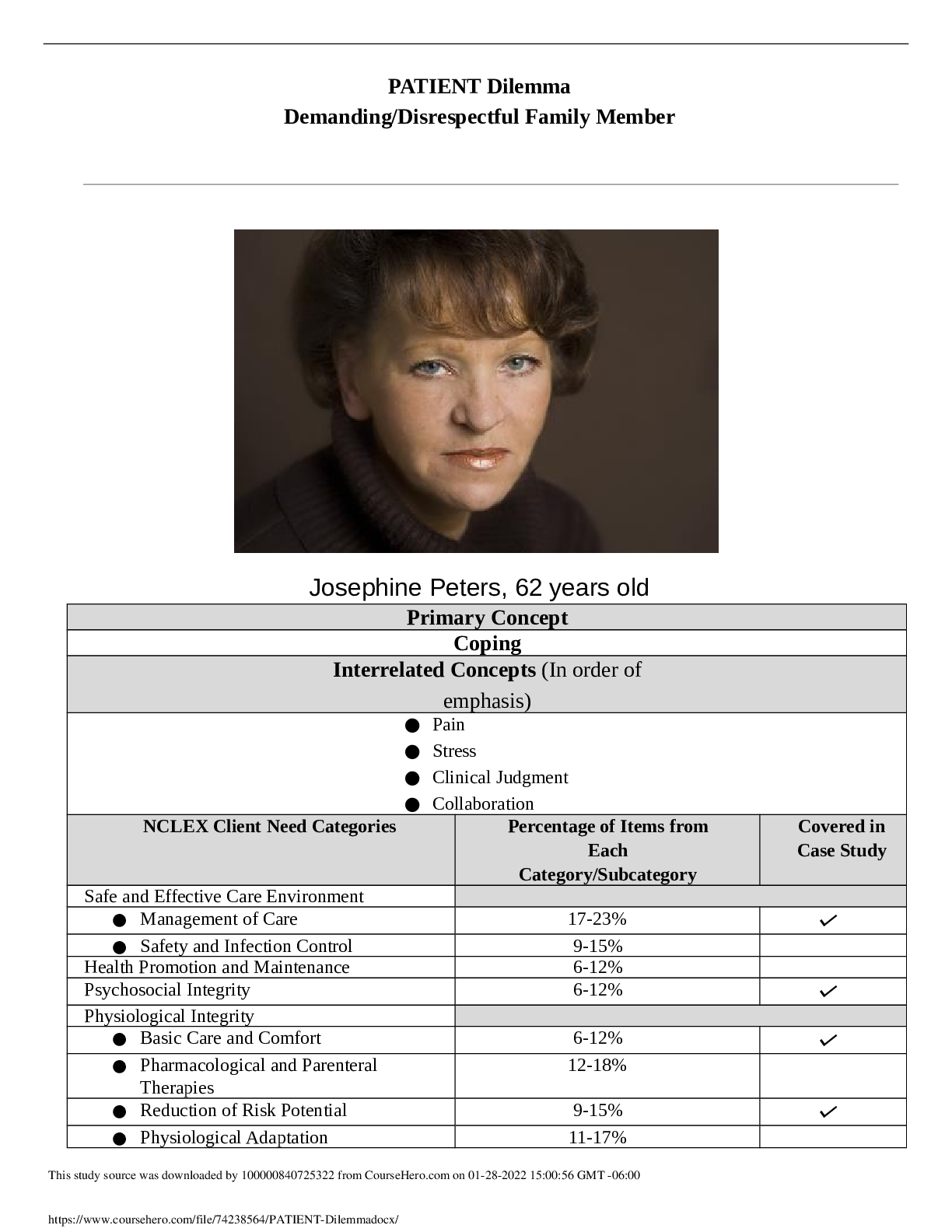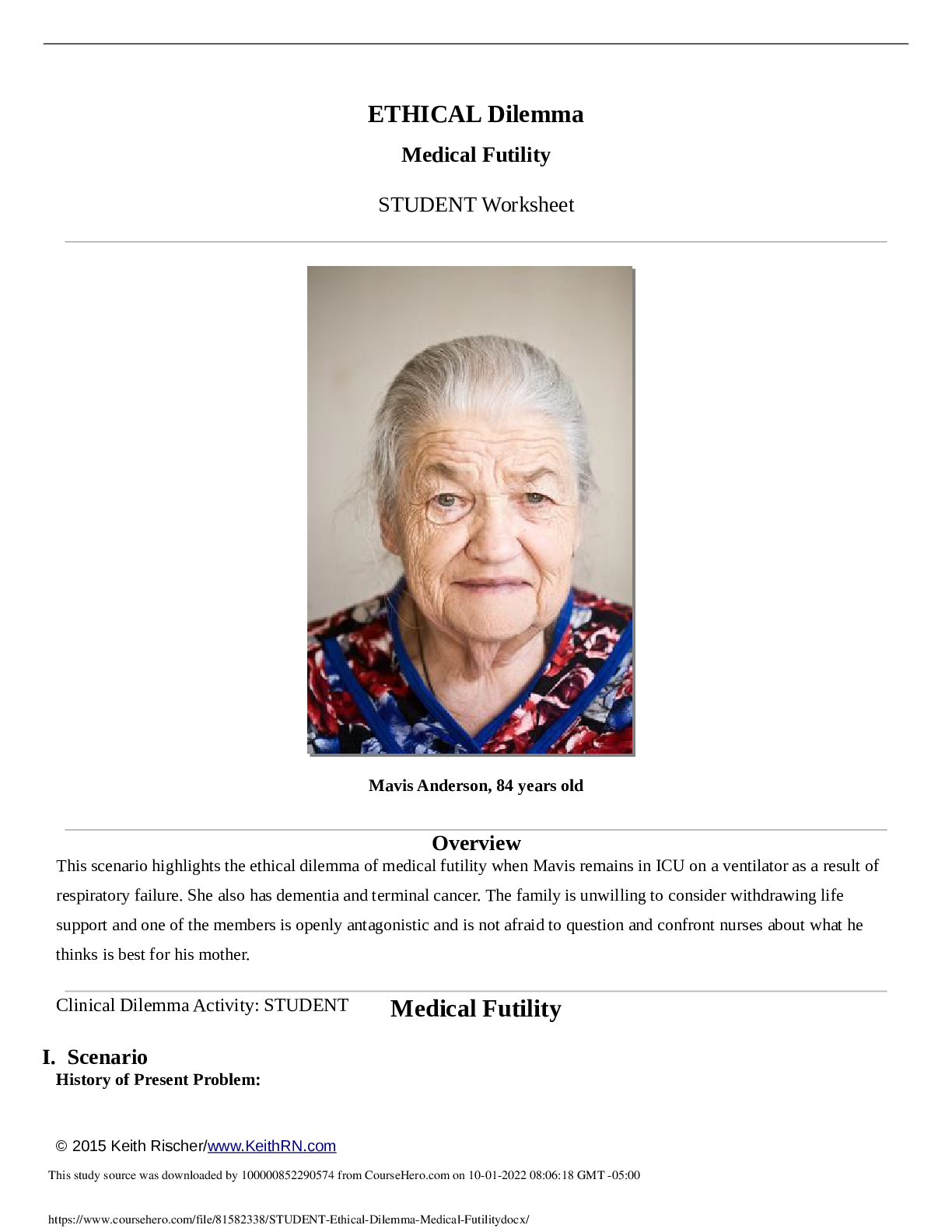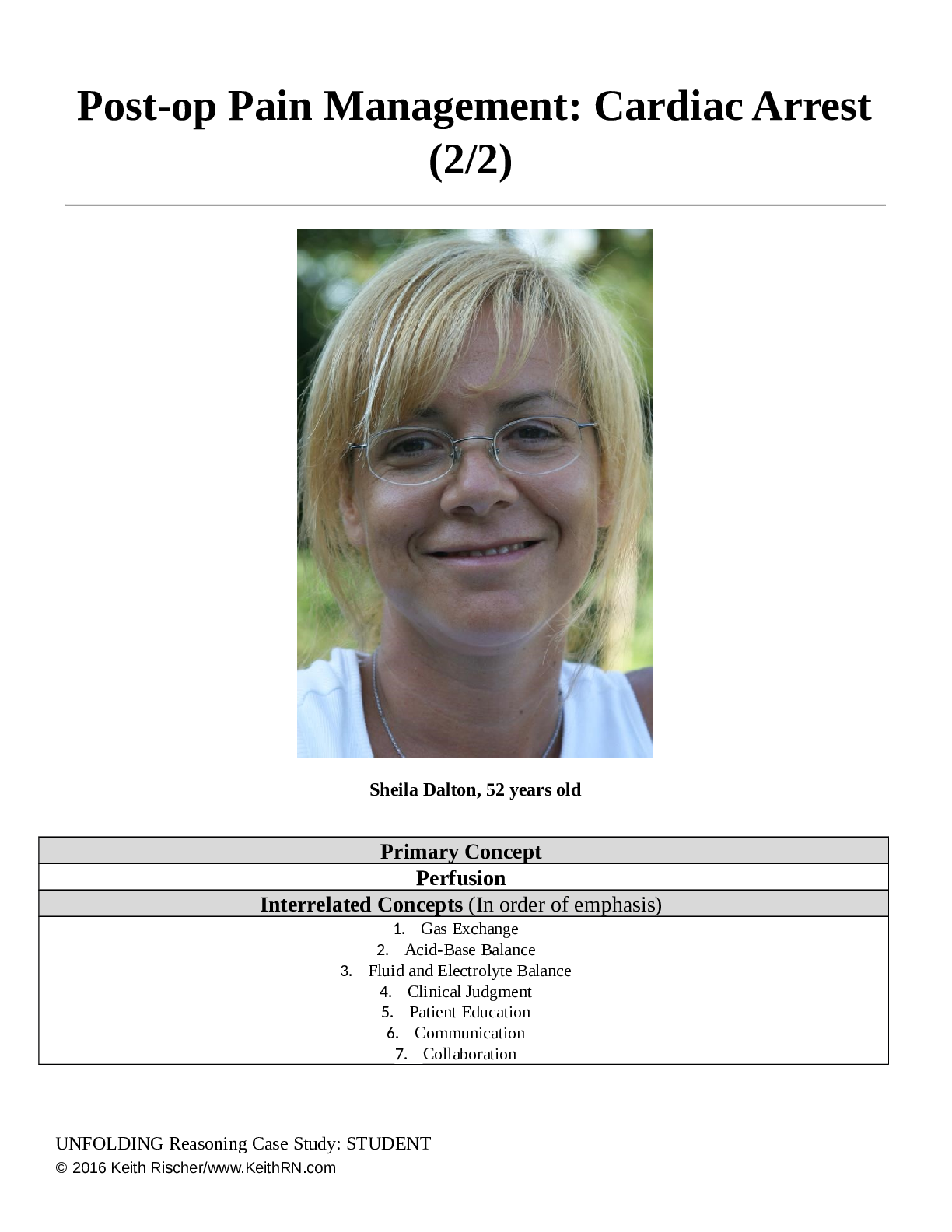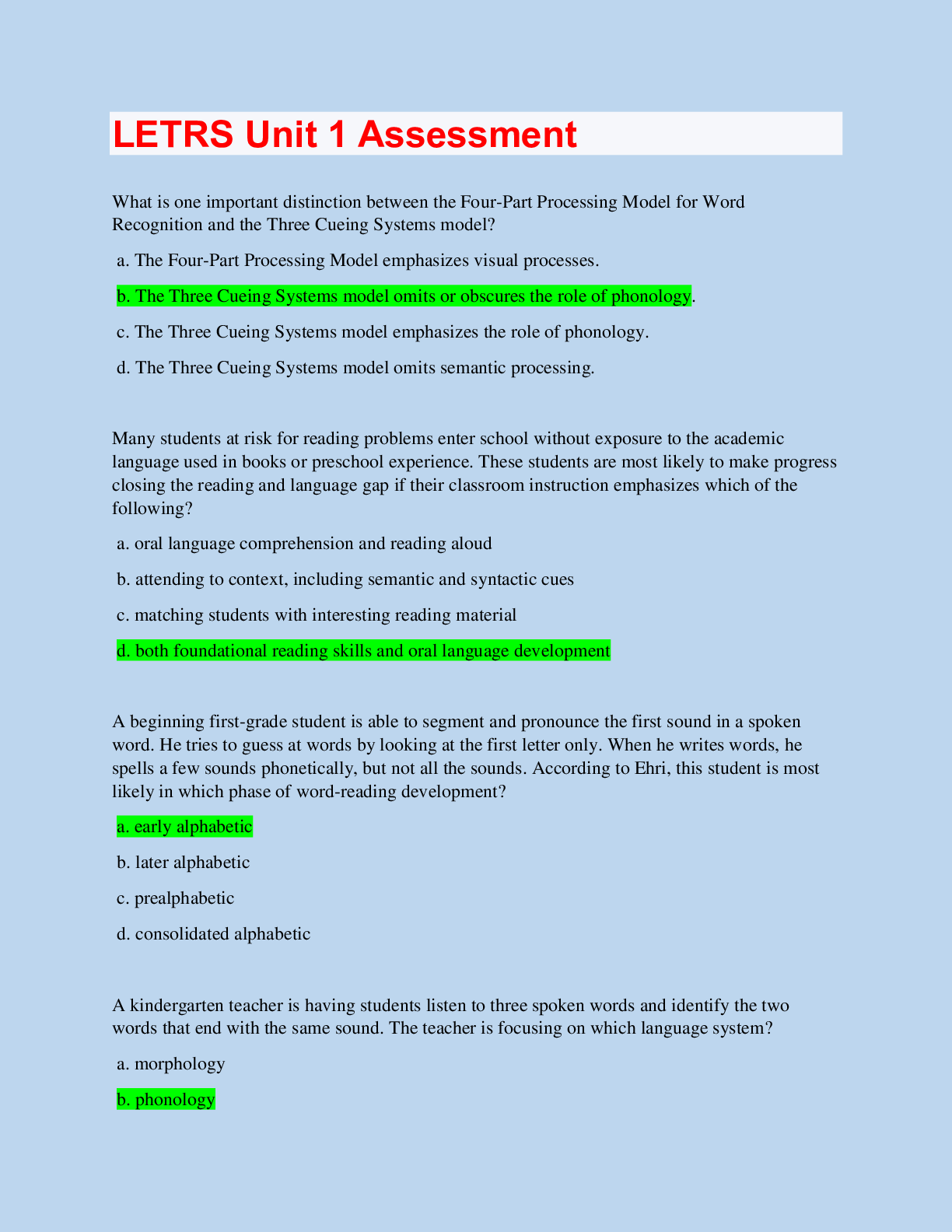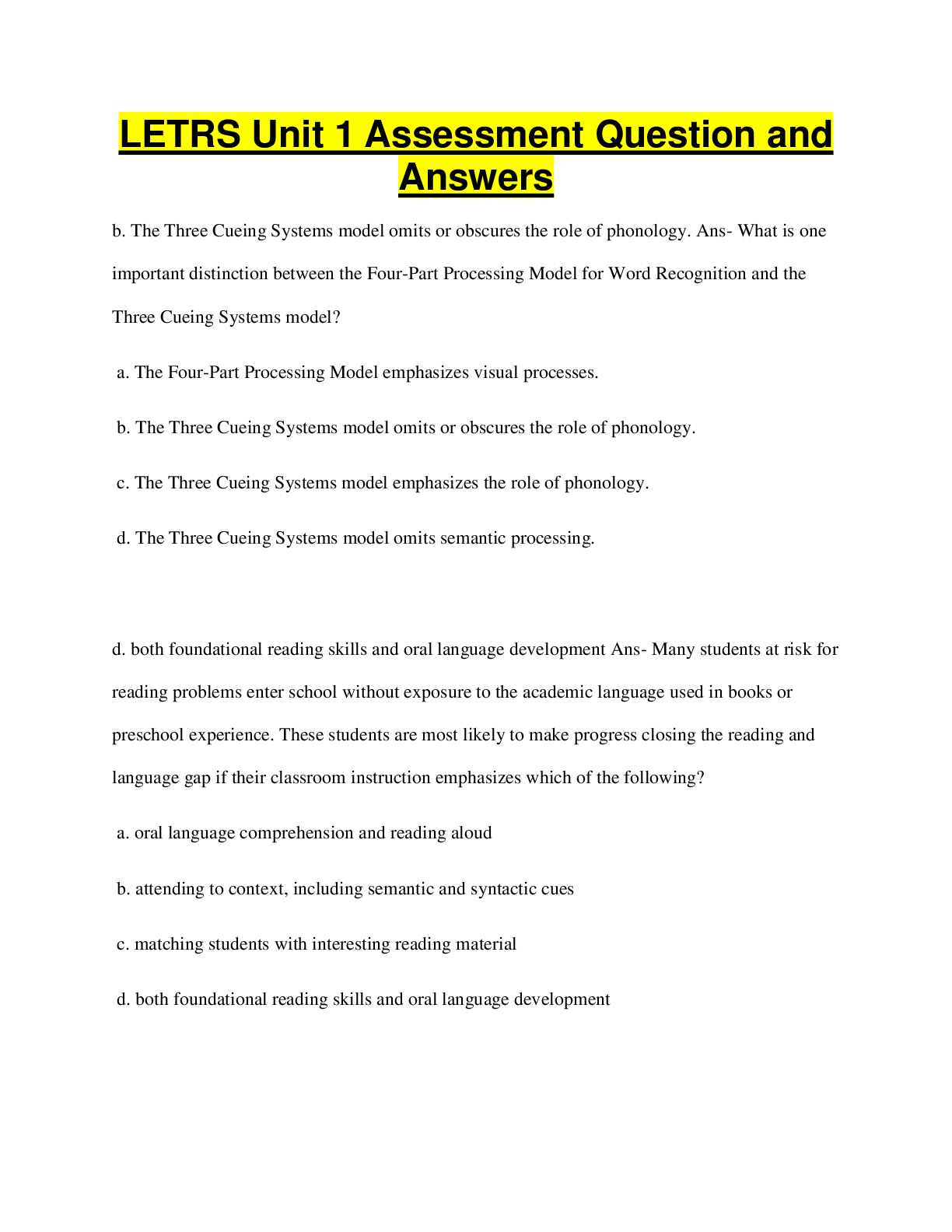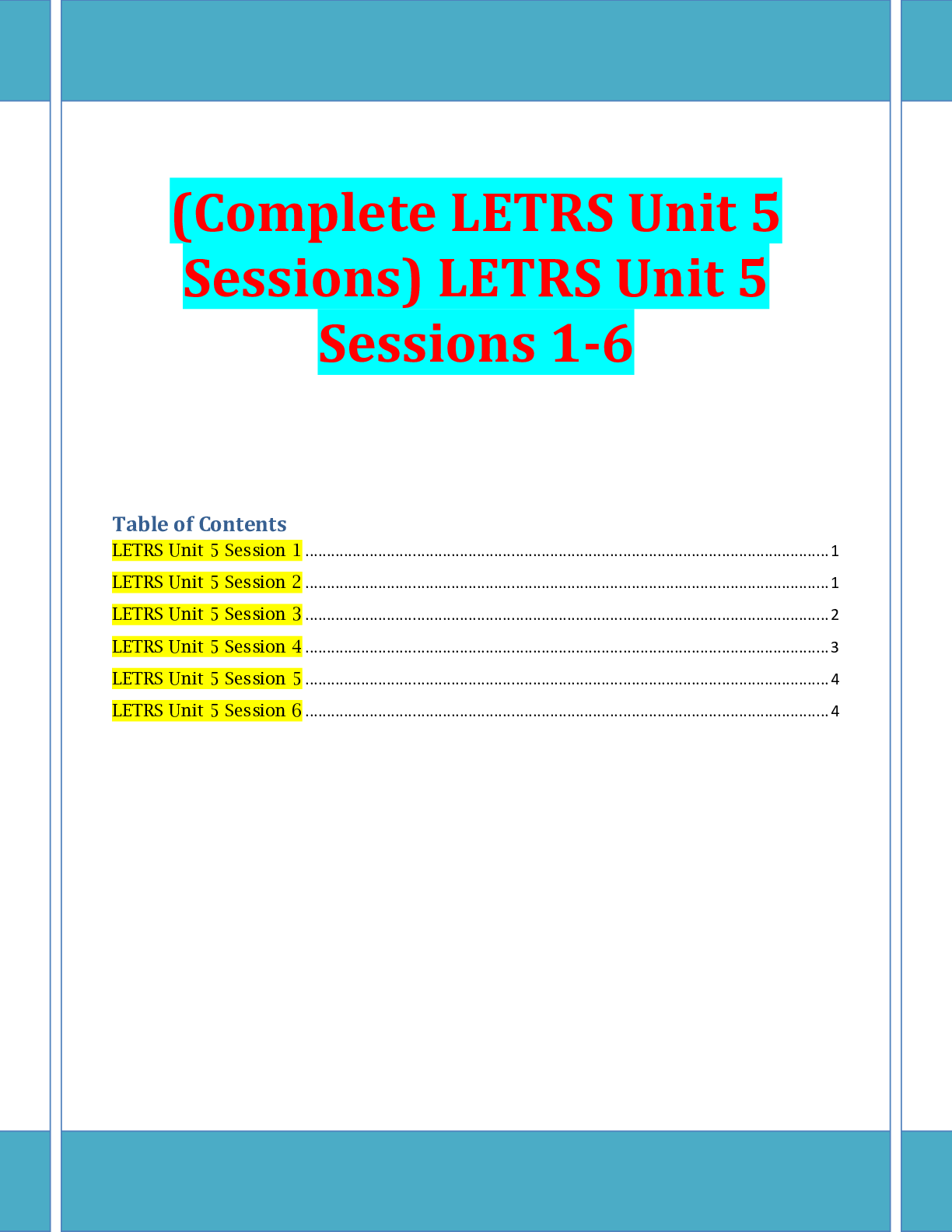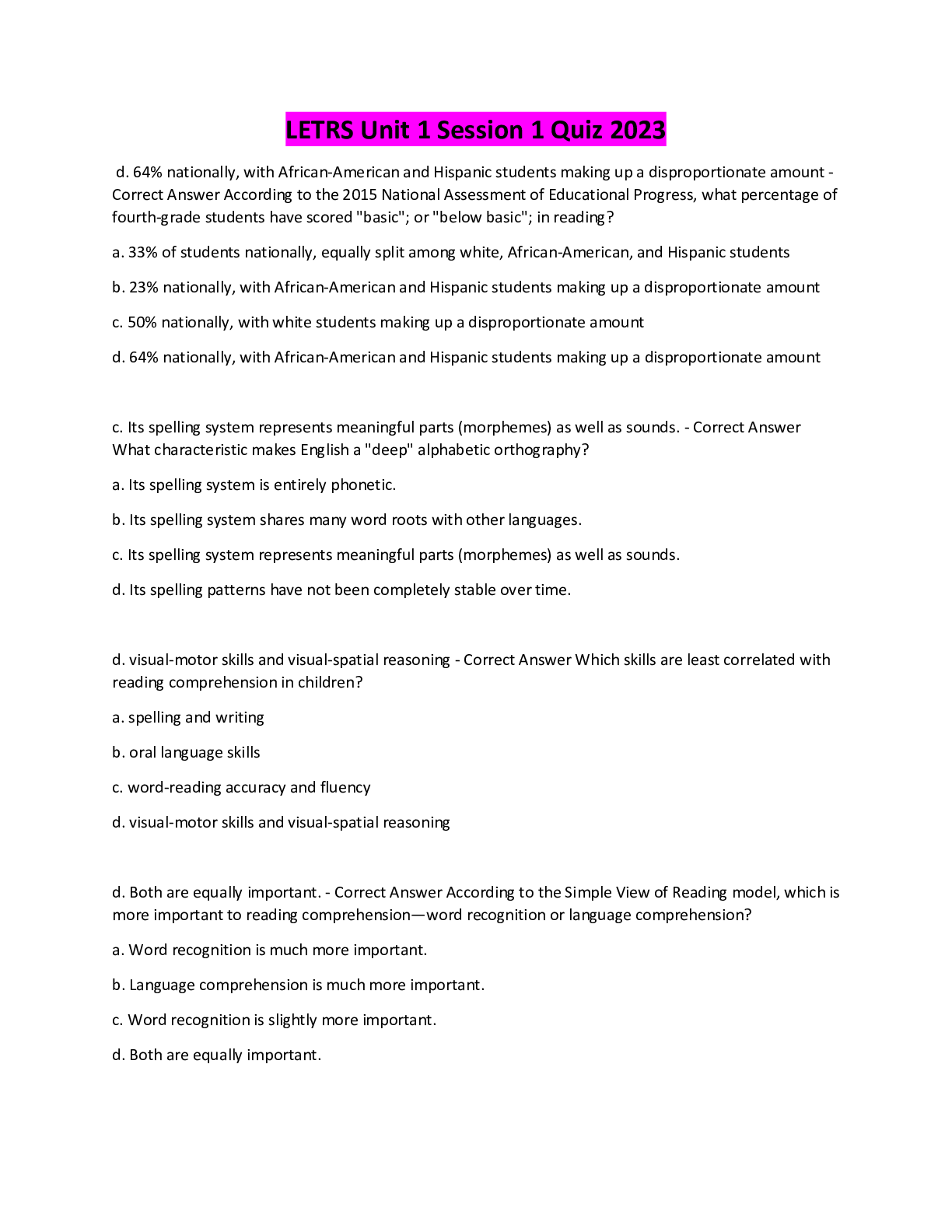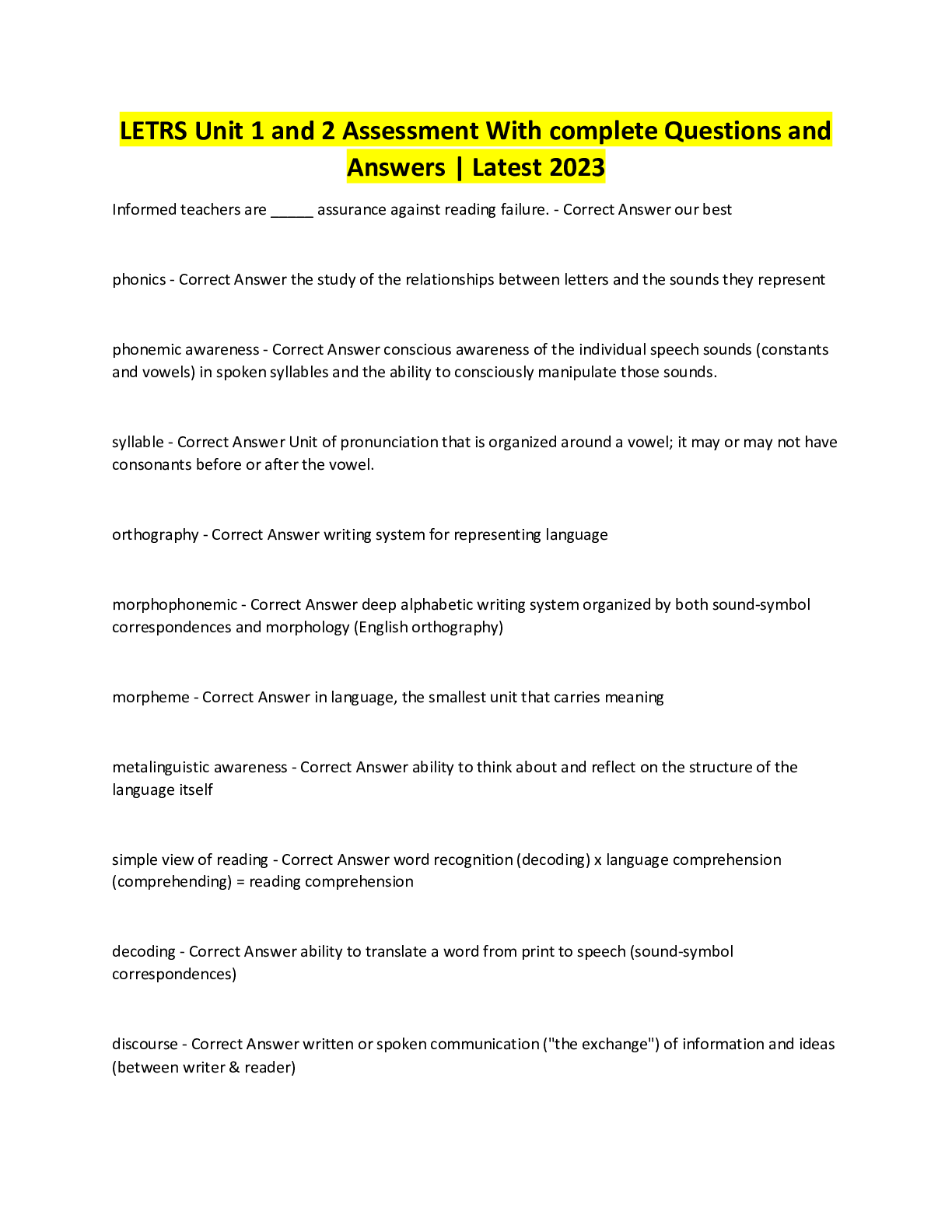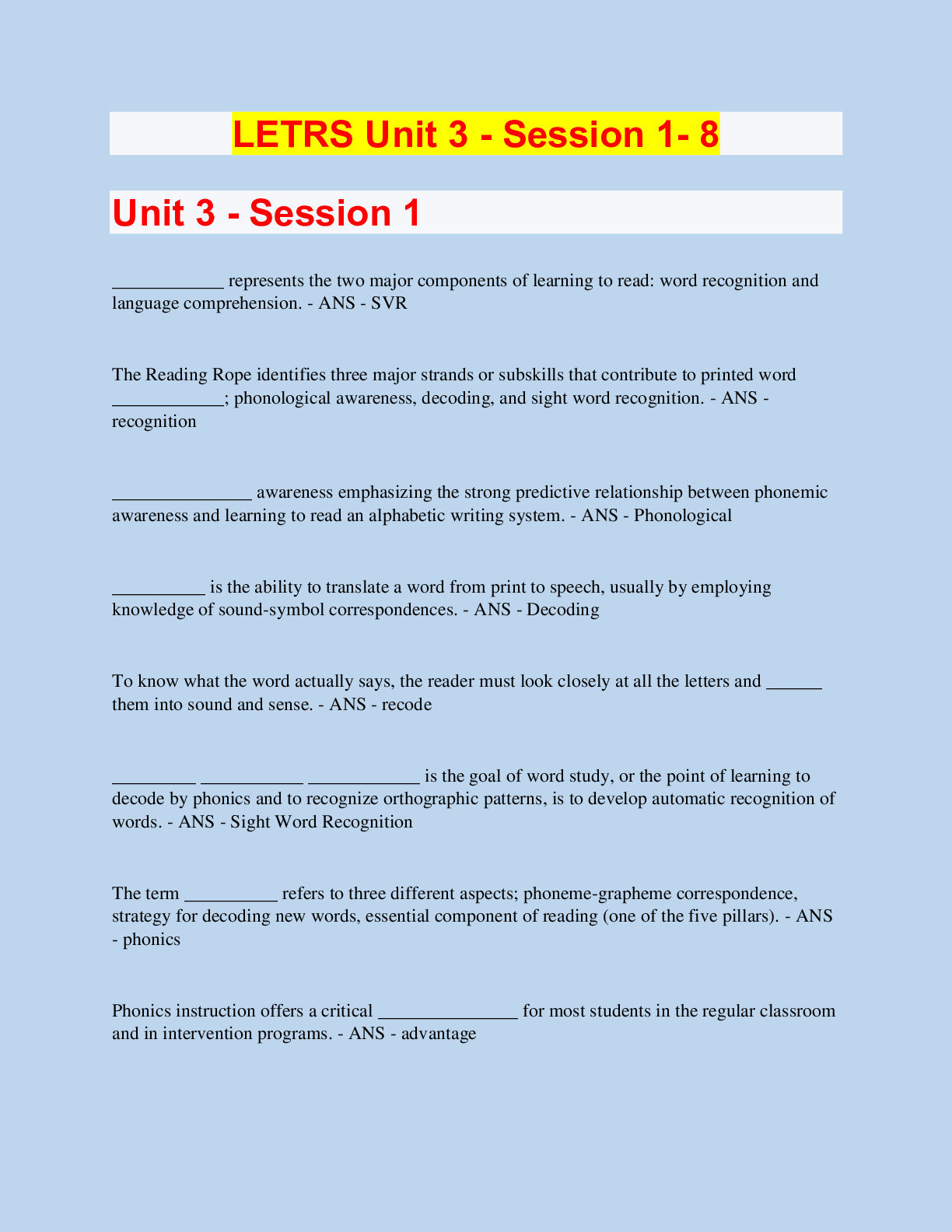*NURSING > EXAM > NURSE Dilemma Student Burnout STUDENT Worksheet _Sheila Dalton 52 years old / NUR 1022C clinicals... (All)
NURSE Dilemma Student Burnout STUDENT Worksheet _Sheila Dalton 52 years old / NUR 1022C clinicals.......
Document Content and Description Below
Post-op Pain Management: Day of Surgery (1/2) Sheila Dalton, 52 years old Primary Concept Pain Interrelated Concepts (In order of emphasis) 1. Gas Exchange 2. Glucose Regulation 3. Perfus... ion 4. Inflammation 5. Clinical Judgement 6. Patient Education Post-op Pain Management: Day of Surgery (1/2) History of Present Problem: Sheila Dalton is a 52-year-old woman who has a history of chronic low back pain and COPD. She had a posterior spinal fusion of L4-S1 today. She had an estimated blood loss (EBL) of 675 mL during surgery and received 2500 mL of Lactated Ringers (LR). Pain is currently controlled at 2/10 and increases with movement. She was started on a hydromorphone patient-controlled analgesia (PCA) with IV bolus dose of 0.1 mg and continuous hourly rate of 0.2 mg. Last set of VS in post-anesthesia care unit (PACU) P: 88; R: 20; BP: 122/76; requires 4 liters per n/c to keep her O2 sat >90 percent. You are the nurse receiving the patient directly from the PACU. Personal/Social History: Sheila is divorced and currently lives alone in her own apartment. She has two grown children from whom she is estranged. What data from the histories are RELEVANT and have clinical significance to the nurse? RELEVANT Data from Present Problem Clinical Significance Chronic low back pain Respirations = 20/min. Requires 4L of oxygen to keep O2 Sat. above 90% Patient on hydromorphone PCA 0.2 mg hourly COPD Pain on a reoccurring basis High respiratory rate, probably because of pain Pt. should report controlled pain levels watch for possible overdose and respiratory depression Anticipated low O2 saturation RELEVANT Data from Social History Clinical Significance Divorced Estranged from two grown children Lives alone She may need additional assistance upon d/c from the hospital. The patient could be at increased risk for falls due to living alone, chronic pain, and need for oxygen. Developing Nurse Thinking by Identifying Significance of Clinical Data Patient Care Begins–Arrives from PACU to Surgical Floor T: 100/2 °F/37.9° C (oral) Provoking/Palliative: Movement/lying still P: 110 (regular) Quality: Ache R: 24 Region/Radiation: Lumbar-incisional BP: 98/50 Severity: 6/10-gradually increasing O2 sat: 88% 4 liters per n/c Timing: Continuous since arrival from PACU What VS data are RELEVANT and must be recognized as clinically significant by the nurse? RELEVANT VS Data: Clinical Significance: 100.2˚F Oral Temp 110 Pulse 24 Respirations 98/50 BP O2 Sat 88% Continuous aching pain in lumbar-incisional region since arrival from PACU rated 6/10 and gradually increasing, aggravated by movement and relieved while lying still Temperature is elevated and could signify a possible infection. Elevated pulse could signify pain/distress. Elevated, likely related to increasing pain Low, could be indicative of oversedation or due to blood loss. Low, likely related to COPD complications Pain level is significant and should be treated and monitored. Current Assessment: GENERAL APPEARANCE Appears uncomfortable, body tense, frequent grimacing–last used PCA 10 minutes ago RESP: Breath sounds clear with equal aeration ant/post but diminished bilaterally, non-labored respiratory effort, occasional moist–nonproductive cough CARDIAC: Pale-pink, warm and dry, no edema, heart sounds regular–S1S2, pulses strong, equal with palpation at radial/pedal/post-tibial landmarks NEURO: Alert and oriented to person, place, time, and situation (x4) GI: Abdomen soft/non-tender, bowel sounds hypoactive and audible per auscultation in all 4 quadrants, c/o nausea GU: Foley catheter secured, urine clear/yellow, 100 mL the past two hours SKIN: Skin integrity intact, skin turgor elastic, no tenting, dressing in place with no drainage noted What assessment data are RELEVANT and must be recognized as clinically significant by the nurse? RELEVANT Assessment Data: Clinical Significance: General Appearance description Pt seems to still be in pain even with the medication Developing Nurse Thinking through APPLICATION of the Sciences Fluid & Electrolytes/Lab/diagnostic Results: Complete Blood Count (CBC) Current: High/Low/WNL? Prior: WBC (4.5-11.0 mm3) 11.8 High 7.2 Hgb (12-16 g/dL) 10.4 Low 15.2 Platelets (150-450 x 103/μl) 220 WNL 258 Neutrophil % (42-72) 85 High 68 Band forms (3-5%) 1 Low 1 What lab results are RELEVANT and must be recognized as clinically significant by the nurse? RELEVANT Lab(s): Clinical Significance: TREND: Improve/Worsening/Stable: WBC 11.8 mm3 Elevated, could indicate Worsening infection Worsening HgB 10.4 g/dL Low, likely related to COPD/O2 Sat 88/Respirations 22/min Neutrophil 85% Elevated, could indicate Worsening bacterial infection Band forms 1% Low, pt. at increased risk for infection Worsening Basic Metabolic Panel (BMP) Current: High/Low/WNL? Prior: Sodium (135-145 mEq/L) 134 WNL 136 Potassium (3.5-5.0 mEq/L) 3.8 WNL 3.9 Glucose (70-110 mg/dL) 148 High 98 BUN (7-25 mg/dl) 20 WNL 22 Creatinine (0.6-1.2 mg/dL) 0.9 WNL 1.1 What lab results are RELEVANT and must be recognized as clinically significant by the nurse? RELEVANT Lab(s): Clinical Significance: TREND: Improve/Worsening/Stable: Glucose 148 mg/dL Blood glucose is elevated. This could be due to pain and emotional stress. An elevated blood sugar could delay healing and increase the chances for surgical-site infection Worsening Lab Planning-Creating a Plan of Care with a PRIORITY Lab: Lab: Normal Value Why Relevant? Nursing Assessment/Interventions Required Hemoglobin Value: 10.4 12-16 g/dl Critical Value: <5 g/dl or >20 g/dl The patient’s hemoglobin is below the normal level; it is crucial that this be monitored closely. Follow up lab draws or a blood transfusion to raise her red blood cell count. Pharmacology: Home Med: Classification: Mechanism of Action (in own words): Nursing Considerations: Atenolol Beta Blocker (Antidysrhythmic) Lowers the response rate of nerve impulses to the heart, thereby slowing down the heart rate and lowering the blood pressure. Lowers blood pressure and heart rate. Lisinopril Angiotensin Converting Enzyme Inhibitor Blocks the mechanisms that cause blood vessels to tighten, thereby relaxing the blood vessels. Lowers blood pressure. Citalopram Selective Serotonin Reuptake Inhibitor Increases the levels of the hormone, serotonin, in the brain by inhibiting the reuptake of it in the nerves. Anti-depressant, anti-anxiety Hydrocodone/ acetaminophen Narcotic Analgesic Binds to opioid receptors, decreasing pain sensation, and inhibits COX enzymes, reducing the compounds that promote inflammation, pain, and fever. Pain, inflammation, fever relief Aspirin Salicylate Affects the clotting cascade by inhibiting clot promoting compounds and promoting clot inhibiting compounds. Anticoagulant Pathophysiology: 1. What is the primary problem that your patient is most likely presenting? Acute pain and low oxygen saturation. 2. What is the underlying cause/pathophysiology of this primary problem? Recent spinal fusion surgery Developing Nurse Thinking by Identifying Clinical RELATIONSHIPS 1. What is the RELATIONSHIP of the past medical history and current medications? (Which medication treats which condition? Draw lines to connect) Past Medical History (PMH) Home Meds: ● Low back pain with lumbar compression Atenolol 50 mg daily fracture Citalopram 40 mg daily ● Depression Acetaminophen/hydrocodone 1-2 tabs every 4 ● COPD hours prn pain ● Hypertension Lisinopril 40 mg daily ● 2 ppd smoker x 32 years Aspirin 81 mg daily 2. Is there a RELATIONSHIP between any disease in PMH that may have contributed to the development of the current problem? (Which disease likely developed FIRST then began a “domino effect”?) PMH: What Came FIRST: ● Low back pain with lumbar compression fracture ● Depression ● COPD ● Hypertension ● 2 ppd smoker x 32 years 2 ppd smoker x 32 years What Then Followed: Hypertension, COPD, Low back pain with lumbar compression fracture, Depression 3. What is the RELATIONSHIP between the primary care provider’s orders and primary problem? Care Provider Orders: How it Will Resolve Primary Problem/Nursing Priority: 1.Hydromorphone PCA–Settings: *Bolus: 0.1–0.3 mg every 10” *Continuous: 0.1–0.3 mg *Max every 4 hours: 6 mg 2.Continuous pulse oximetry 3. Ondansetron 4 mg IV push every 4 hours prn nausea 4. Titrate O2 to keep sat >90% 5. Incentive spirometer (IS) 5–10x every hour while awake 6. 0.9% NS 100 mL/hour IV 7. Clear liquids/advance diet as tolerated 8. Apply lumbar orthotic brace when up in chair or ambulating 9. Basic Metabolic Panel (BMP) in morning 10.Complete Blood Count (CBC) in morning 1. Will decrease pain level/keep pain under control. 2. Will monitor patient oxygen saturation and need for high levels of oxygen. 3. Will keep patient comfortable. 4. Will keep patient oxygen saturation at acceptable levels. 5. Will expand patient’s lungs, decreasing pain level and need for high levels of oxygen 6.Will keep patient hydrated and balance electrolytes 7. Will keep patient from being nauseated by advancing too quickly after surgery and increase fluid intake 8. Will decrease patient pain level and increase mobility 9. Will allow for a trend and continued monitoring of patient’s laboratory values 10. Will allow for a trend and continued monitoring of patient’s abnormal CBC levels. Developing Nurse Thinking by Identifying Clinical PRIORITIES 1. Which Orders Do You Implement First and Why? Care Provider Orders: Order of Priority: Rationale: 1.Hydromorphone PCA 2.Continuous pulse oximetry 3.Ondansetron (Zofran) 4 mg IV push every 4 hours prn nausea 4.Titrate O2 to keep sat >90% 5.Incentive spirometer (IS) 6.Apply lumbar orthotic brace when up in chair or ambulating 7.Clear liquids/advance diet as tolerated 4.Titrate O2 to keep sat >90% 2.Continuous pulse oximetry 5.Incentive spirometer (IS) 1. Hydromorphone PCA 7.Clear liquids/advance diet as tolerated 3.Ondansetron (Zofran) 4 mg IV push every 4 hours prn nausea 4, 2, 5. Respiratory depression is a high possibility following anesthesia and opioid use. 1.Minimize the pain level. 7. Help maintain fluid/electrolyte balances. Monitor outputs for blood. 3. Minimize the nausea level 6.Apply lumbar orthotic brace when up in chair or ambulating 6. Stabilize the spinal infusion and prevent increased main due to movement. 2. What nursing priority(ies) will guide your plan of care? (if more than one-list in order of PRIORITY) 1. Airway, breathing, and circulation 2. nutrition, fluids, and elimination 3. pain and comfort 3. What interventions will you initiate based on this priority? Nursing Priority: Nursing Interventions: Rationale: Expected Outcomes: Airway, breathing, and circulation Incentive spirometer, oxygen therapy, pulmonary hygiene, frequent vital sign measurement These are the most important priorities according to Maslow’s hierarchy of needs and ultimately affect patient welfare the most. Patient will require less oxygen and increase lung expansion as time progresses post-op Nutrition, fluids, elimination Pain and comfort Encourage fluid intake, encourage activity, IV fluid therapy, toileting schedule, bladder scanning, advance diet as tolerated Patient’s pain level and vital signs will continue to be monitored. Increase activity level and reposition at minimum every two hours. According to Maslow’s hierarchy of needs, these are second priority but still require adequate attention. According to Maslow’s hierarchy of needs, these are next in priority and require attention for patient welfare. Patient will eliminate within one shift post op and output >30 mL of fluid. Patient will maintain balanced fluid/electrolyte status. Patient will advance to a solid diet. Patient’s will be up and walking within the first shift after surgery. Patient’s pain will be under control, and patient will be comfortable as much as able. 4. What are the PRIORITY psychosocial needs that this patient and/or family likely have that will need to be addressed? The pt priority psychosocial needs will likely be security needs, love and belonging needs, self-esteem needs, and self-actualization needs. Since her family is not present or involved in her life and will rely on the healthcare staff for these needs. 5. How can the nurse address these psychosocial needs? Pt does not have close family members nearby, she will rely on the nursing staff for many of her psychosocial needs. The nurse can address these by ensuring her safety and involvement in her care, initiating hourly rounding and educating her about each step of her care, treating her with respect and dignity, and promoting her independence 6. What educational/discharge PRIORITIES will be needed to develop a teaching plan for this patient and/or family? Medication teaching, pain management education, and possible referrals to a rehabilitation, TCU, or skilled nursing facility to aid her with her ADLs. Caring & the “Art” of Nursing 1. What is the patient likely experiencing/feeling right now in this situation? The pt is likely worried about what will happen after she discharges from the hospital and how difficult her recovery will be. This combined with her lack of support system is probably putting a lot of strain on her, as she could lose some independence for a while. She is also likely scared that she will continue to have pain despite the surgery. 2. What can I do to engage myself with this patient’s experience, and show that he/she matters to me as a person? I can listen to her concerns, answer any questions she may have, offer support groups and home assistance, present open-ended questions in order to allow the patient to speak freely about her emotions and feelings. I can also use her preferences, beliefs, and past experiences to create a personal and individualized care. Use Reflection to THINK Like a Nurse Reflection-IN-action (Tanner, 2006) is the nurse’s ability to accurately interpret the patient’s response to an intervention in the moment as the events are unfolding to make a correct clinical judgment and transfer what is learned to improve nurse thinking and patient care in the future. 1. What did I learn from this scenario? In this scenario I learned how to organize and understand the full aspect of care for a post-operational patient. I was able to use all of my resources, prior knowledge, and developing nurse intuition in order to make inferences about my patient’s care. In this scenario, I was able to promote my own independence by applying knowledge that I have learned about the nursing process, individualized patient care, pain-relief, and peri-operational care. Overall, I felt that this scenario allowed for knowledge expansion and affirmation. 2. How can I use what has been learned from this scenario to improve patient care in the future? I can use my knowledge from this scenario to view the entire aspect of a patient’s care and take into account all of their needs based on past medical history, subjective data, objective data, and acute needs. This experience will help me in the future when developing plans for patient care, especially in the post-operational setting. I can also use the knowledge that I learned from this scenario to develop individualized care based on a patient’s social and medical history. Brandi Griffin [Show More]
Last updated: 1 year ago
Preview 1 out of 11 pages

Reviews( 0 )
Document information
Connected school, study & course
About the document
Uploaded On
Aug 06, 2021
Number of pages
11
Written in
Additional information
This document has been written for:
Uploaded
Aug 06, 2021
Downloads
0
Views
30

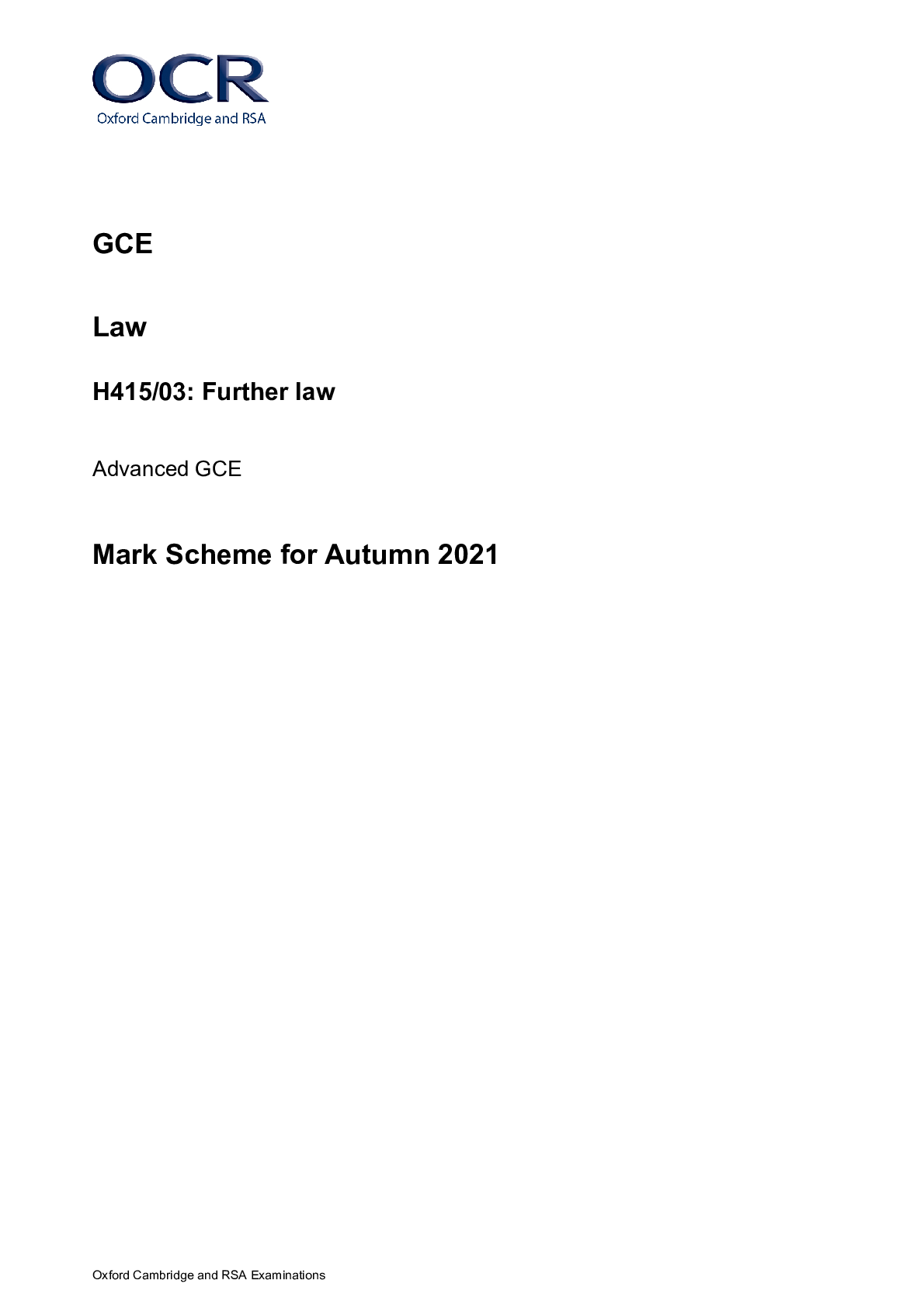
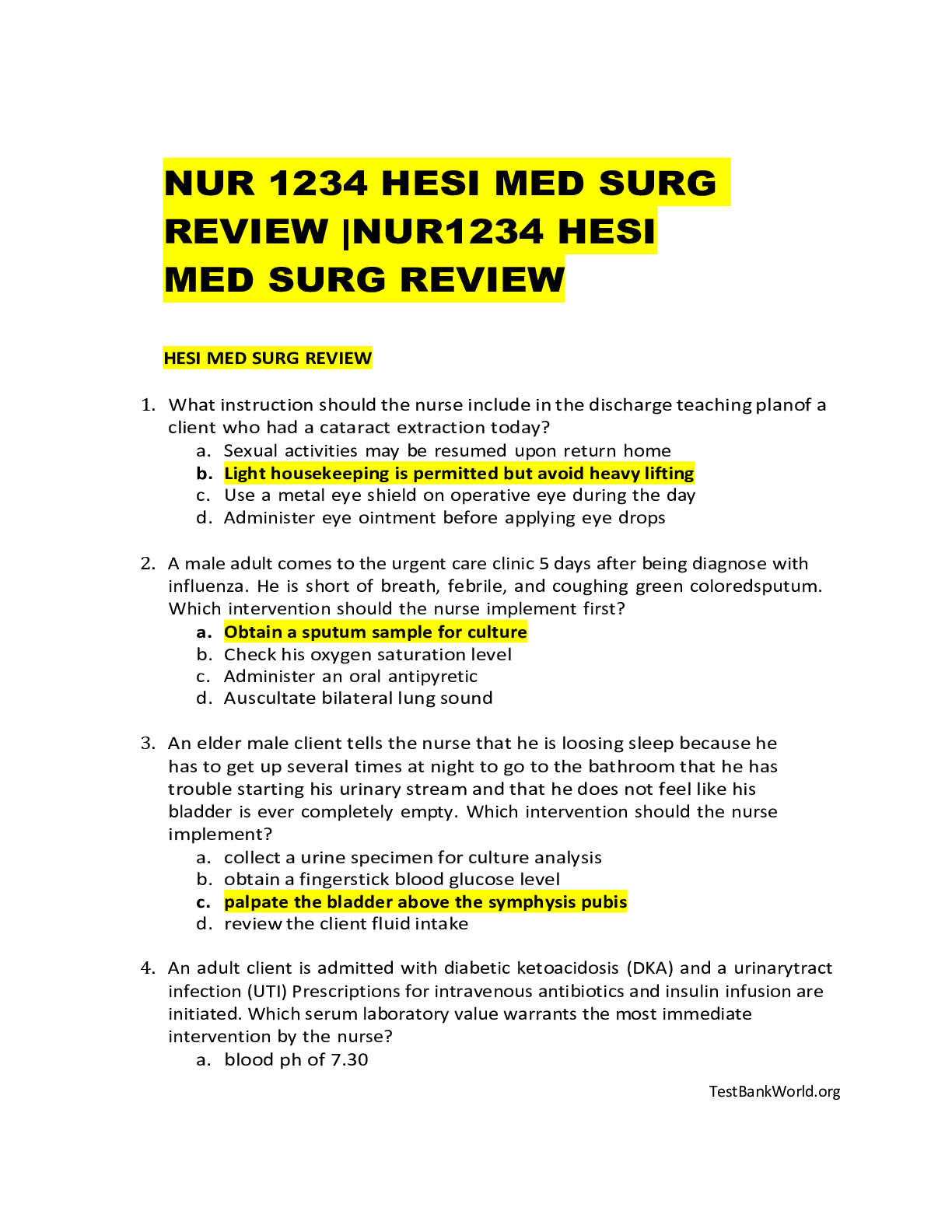
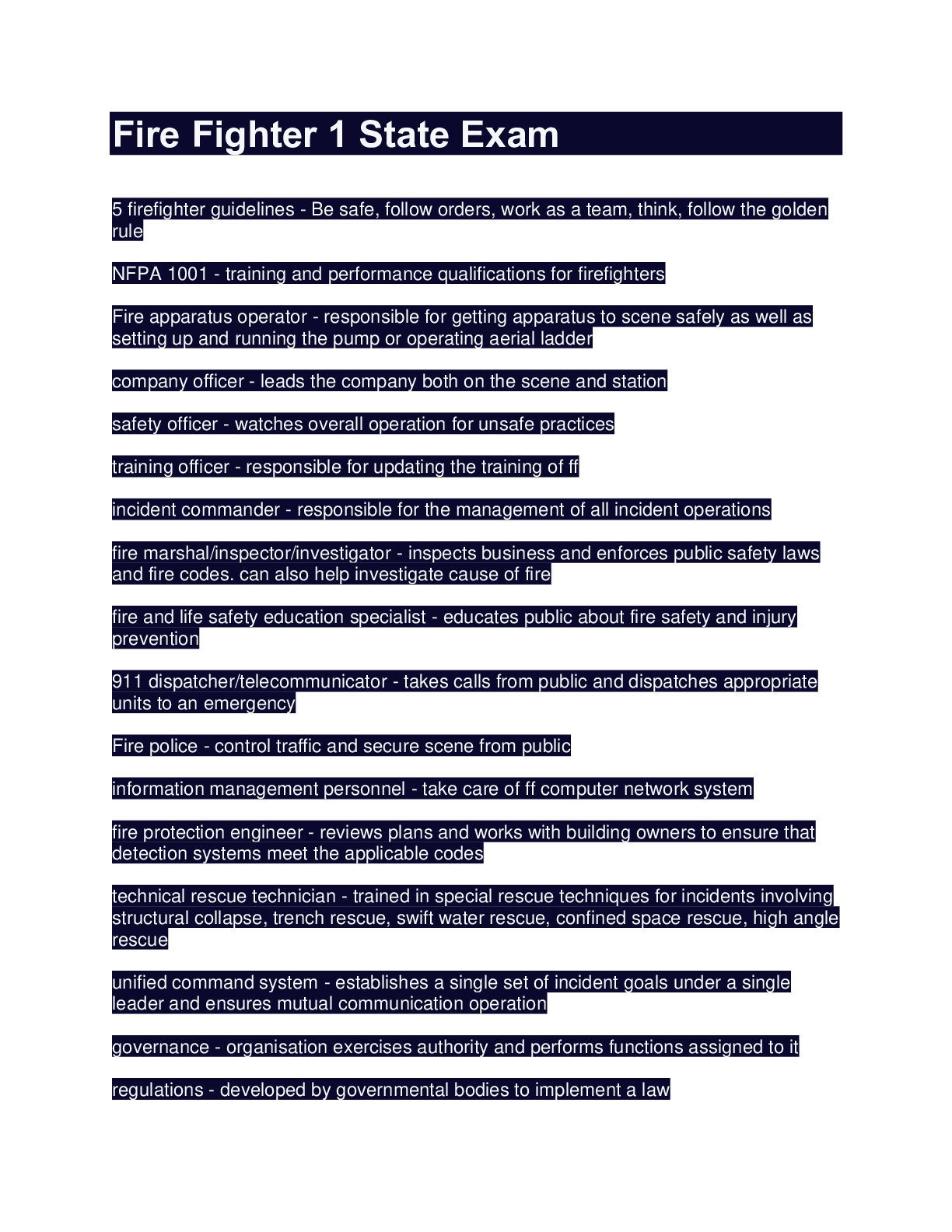

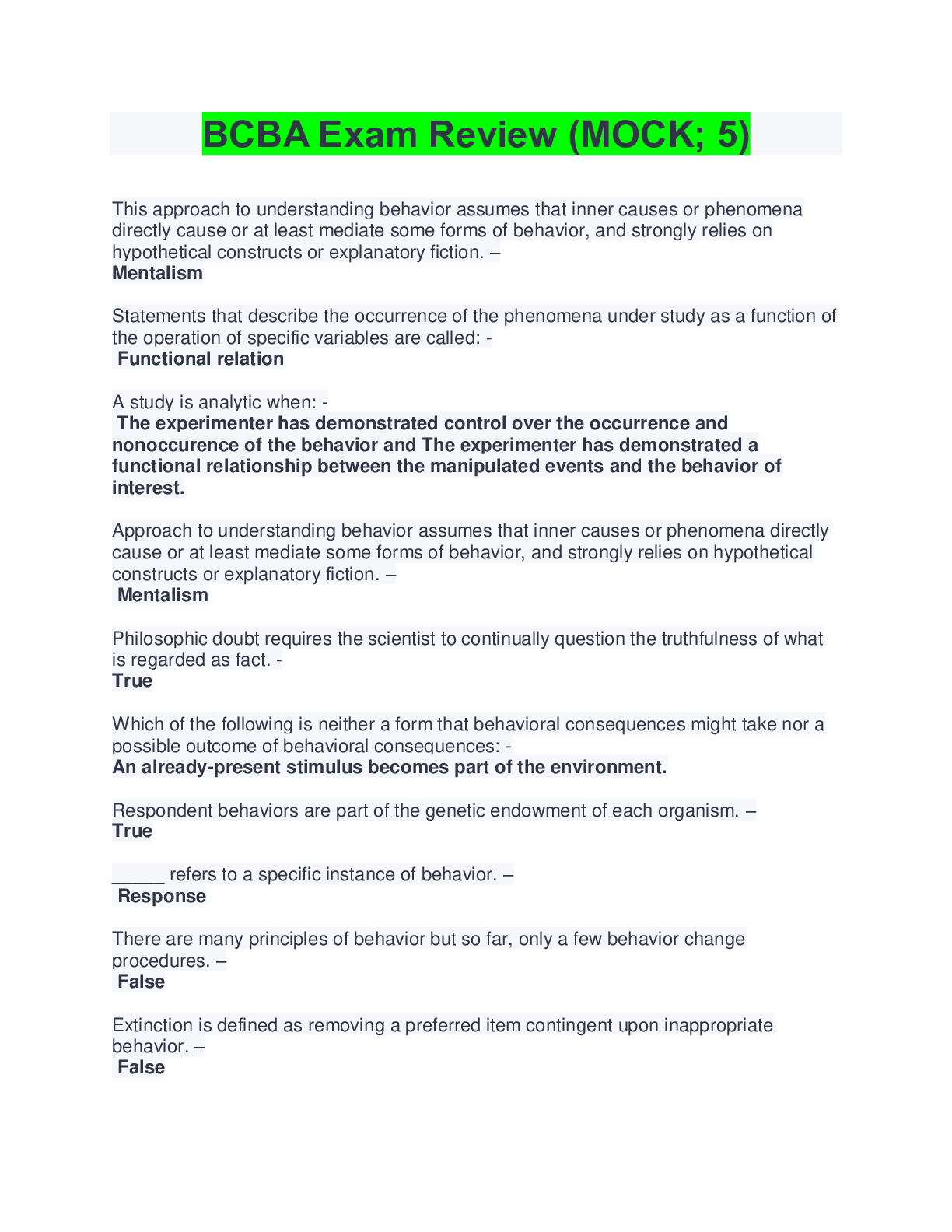


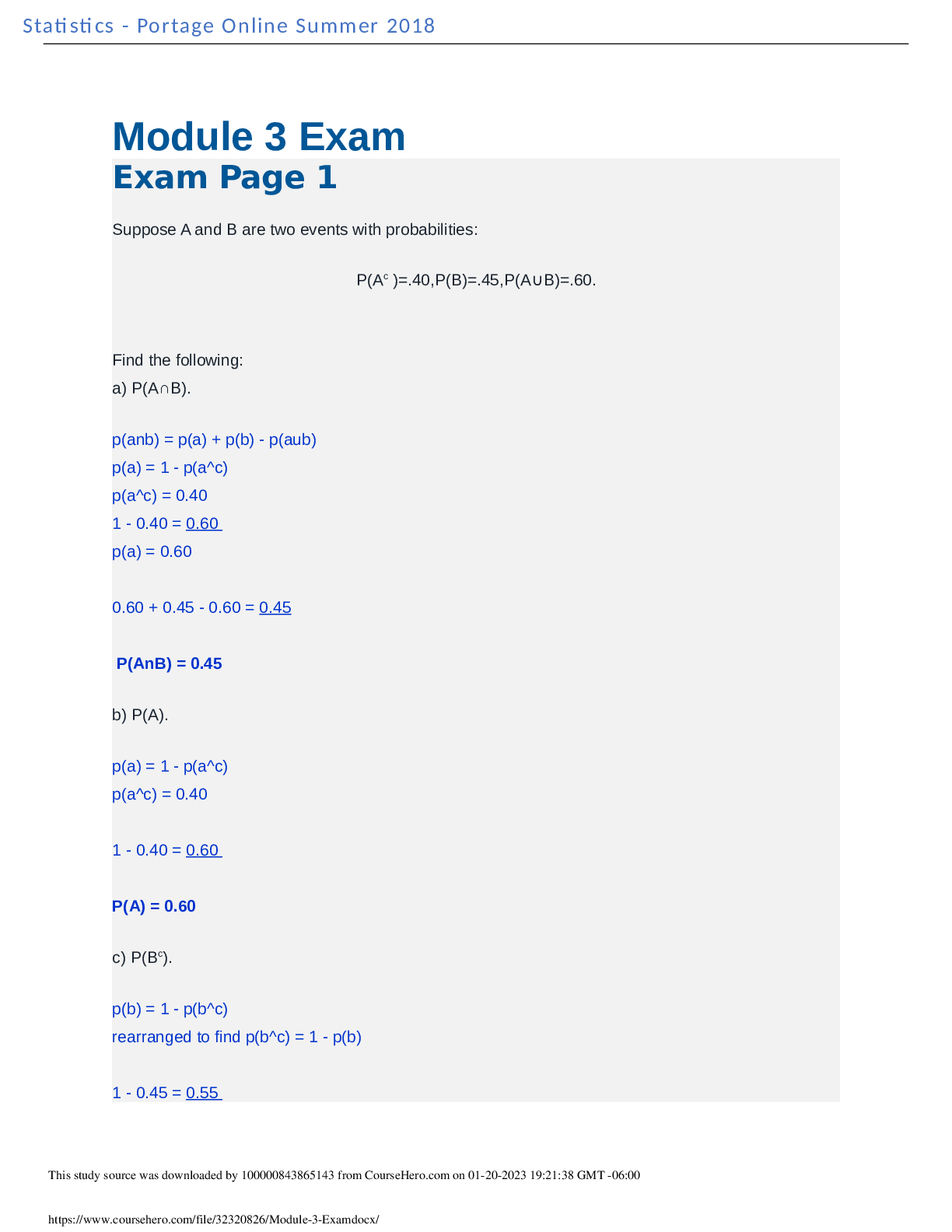
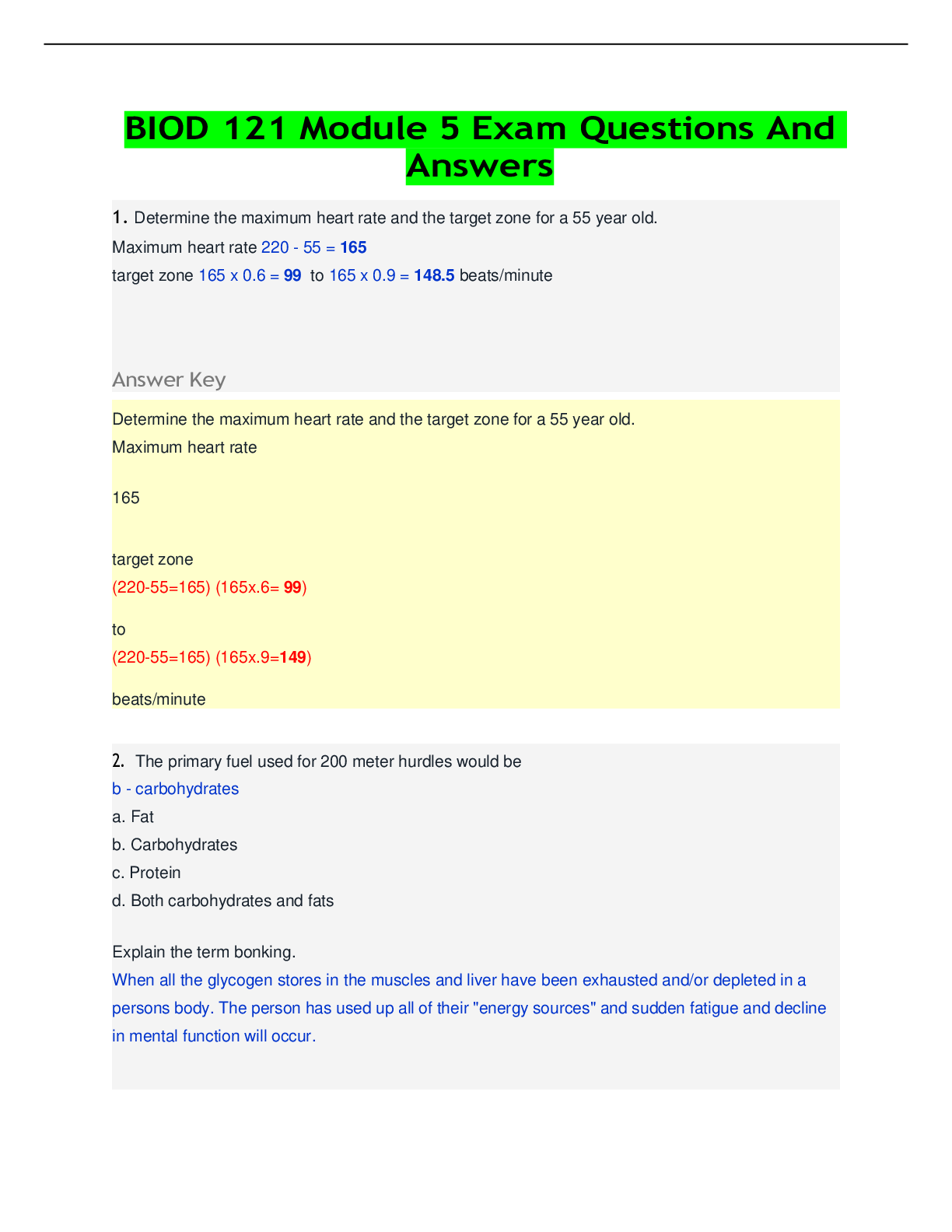

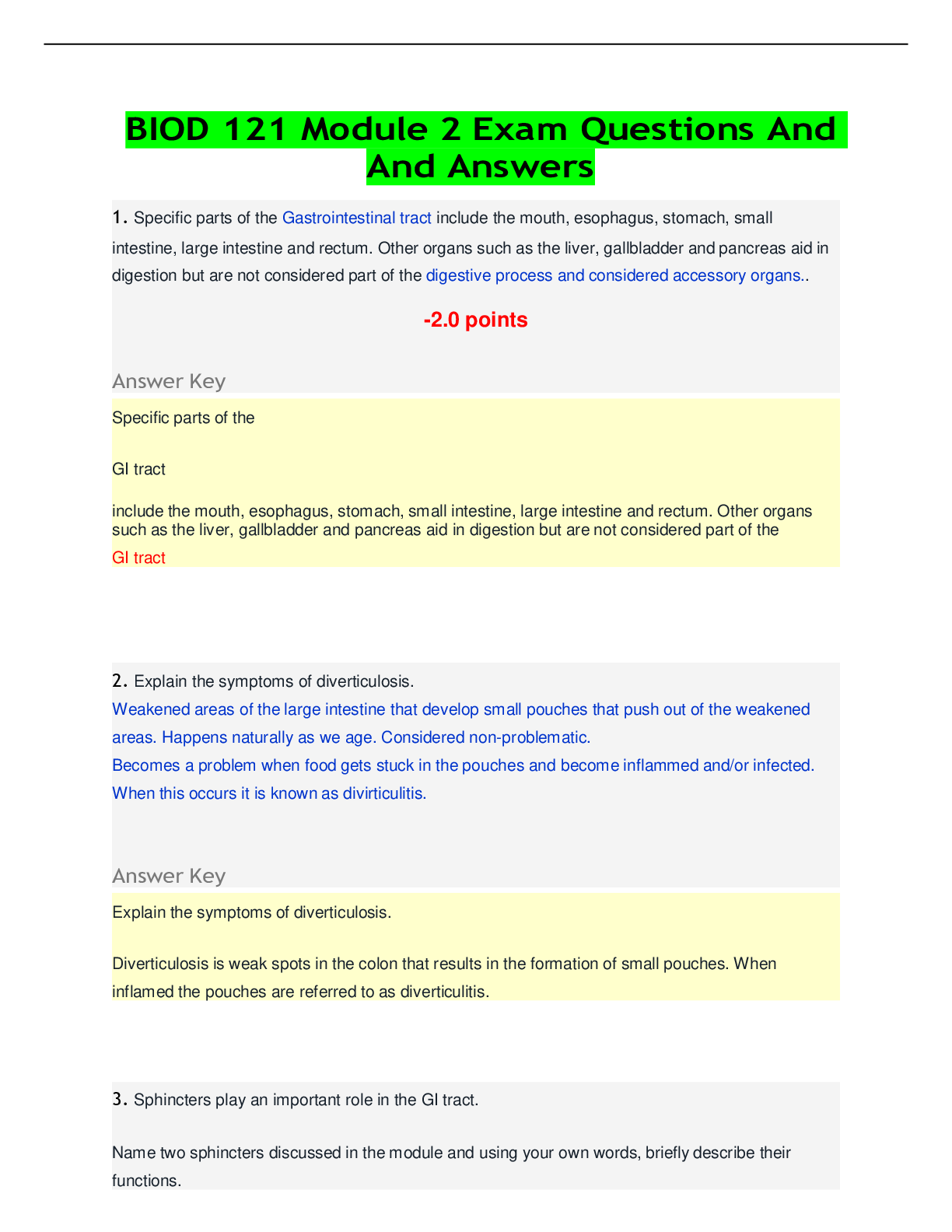

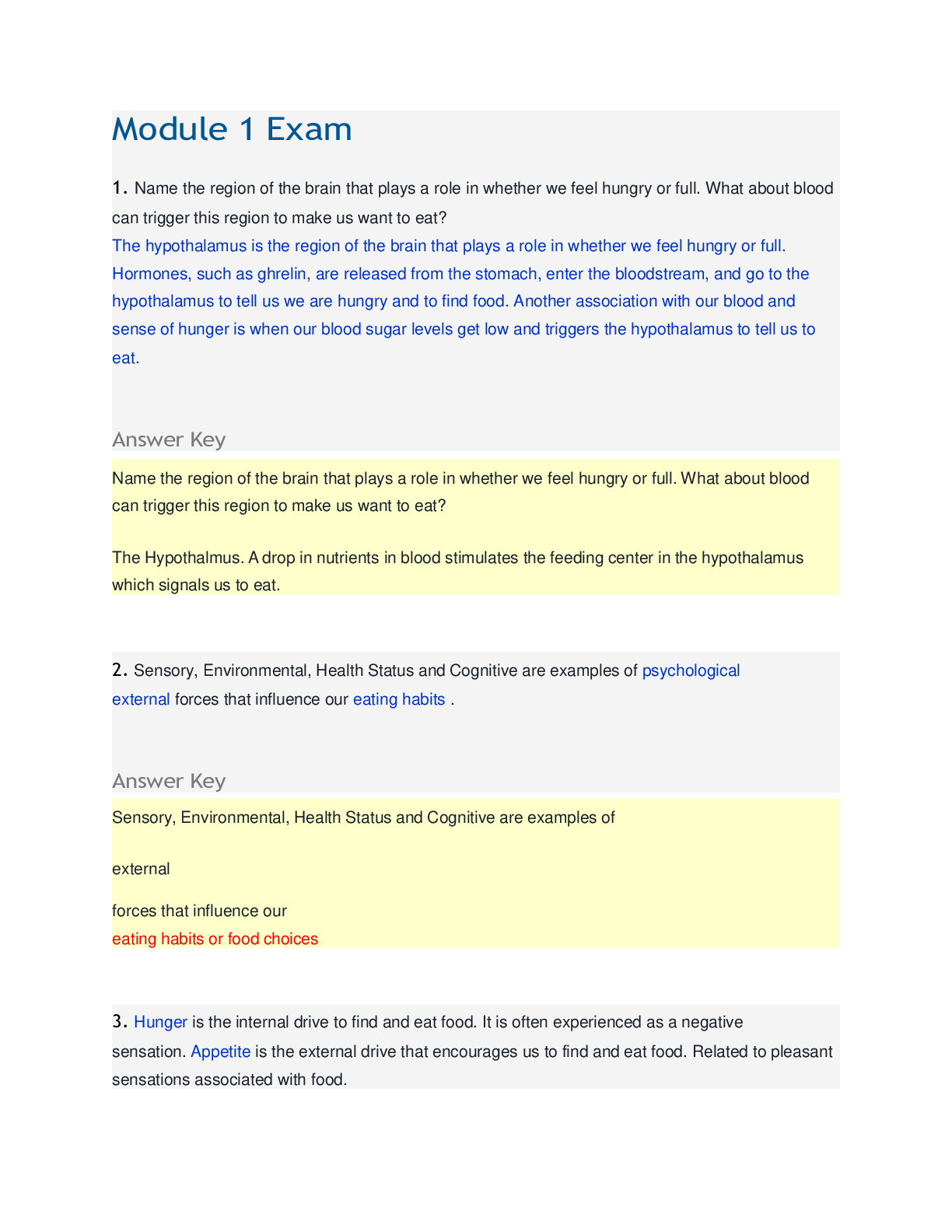
 (1).png)
 (1).png)
 (1).png)
